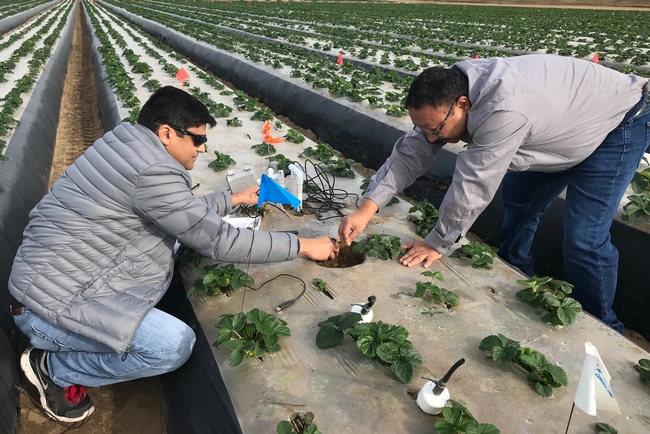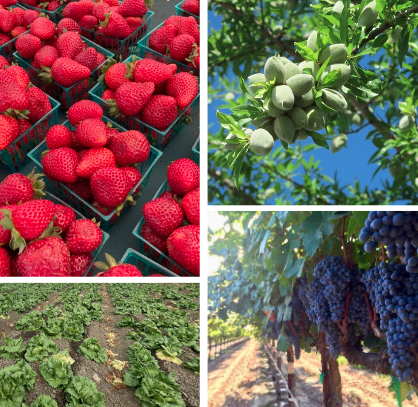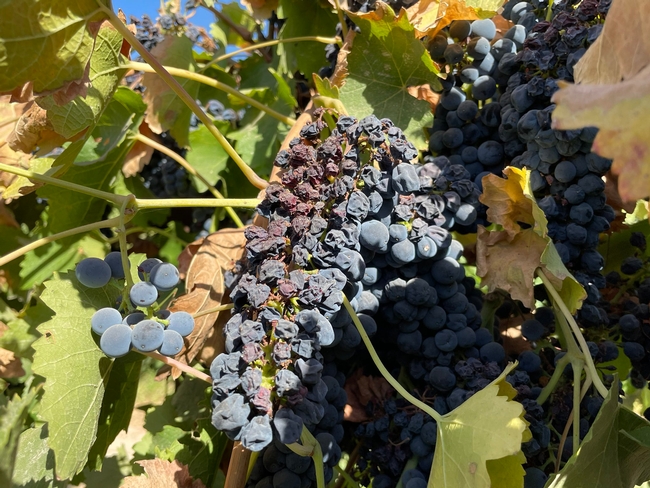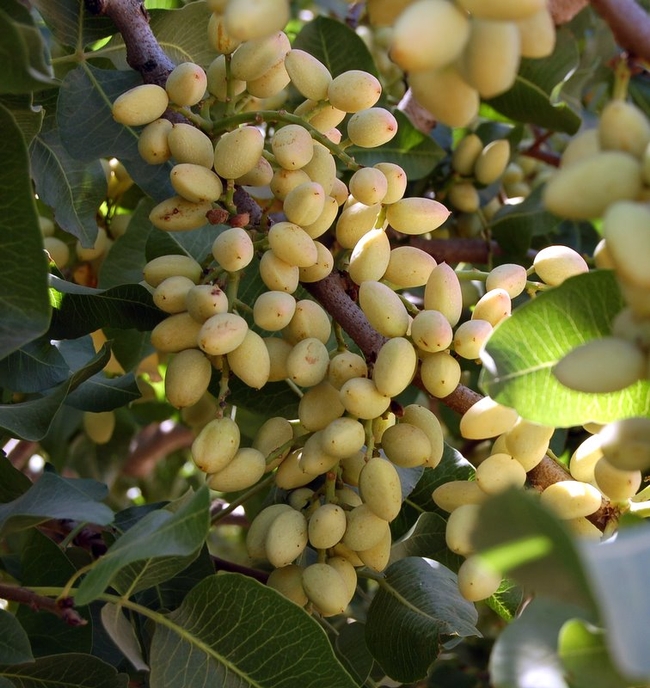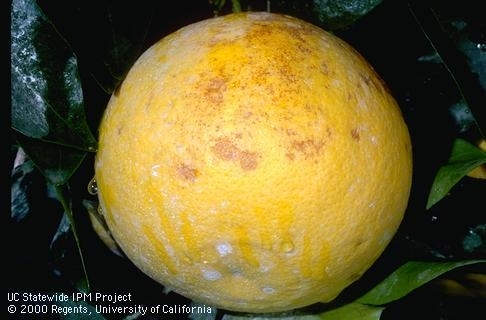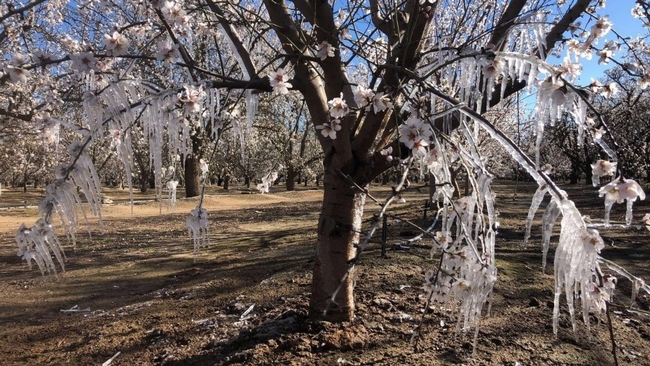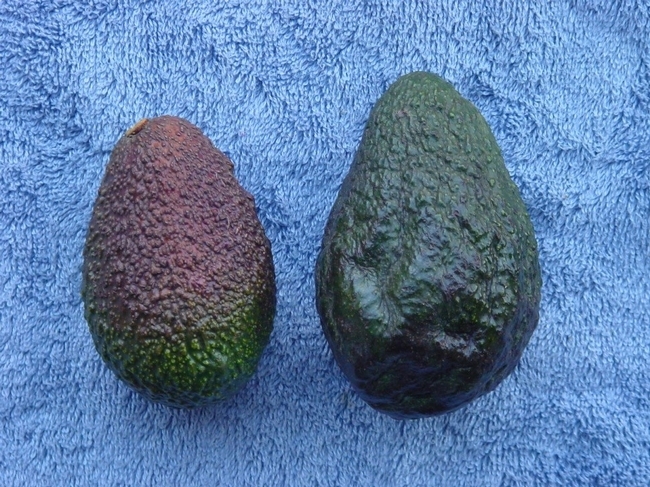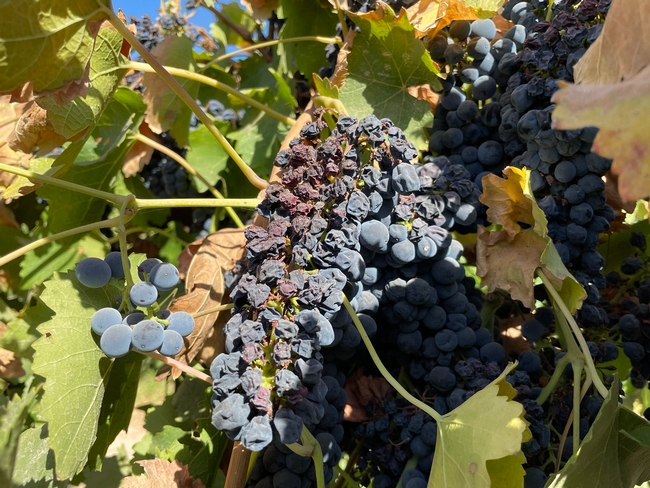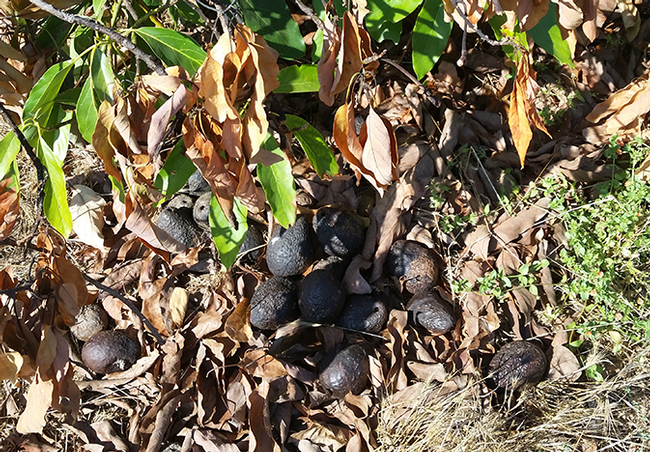
Posts Tagged: Tapan Pathak
Water risks to agriculture: Too little and too much
Water is among the most precious resources on the planet. Some areas don't get enough; some get too much. And climate change is driving both of those circumstances to ever-growing extremes.
Two UC Merced experts in civil and environmental engineering took part in a recent report by the Environmental Defense Fund examining the issue and potential solutions. Associate Professor of Extension Tapan Pathak and Professor Josué Medellín-Azuara co-authored the report, "Scarcity and Excess: Tackling Water-Related Risks to Agriculture in the United States," and wrote the section pertaining to California.
In addition to climate change, disruptive human interventions such as groundwater over-extraction, sprawling drainage networks and misaligned governance are driving up water-related agricultural costs, particularly in midwestern and western states, the researchers found.
The problem is magnified in California, which hosts the largest and the most diverse agricultural landscape in the U.S., Pathak and Medellín-Azuara wrote, with gross revenues from farms and ranches exceeding $50 billion.
"Due to the favorable Mediterranean climate, unique regional microclimate zones, a highly engineered and developed water supply system, and a close connection between producers and research and cooperative extension institutions, California's agricultural abundance includes more than 400 commodities, some of which are produced nowhere else in the nation," the UC Merced researchers wrote.
But the state's varying climate and water needs pose a challenge. Though most of the precipitation falls in the northern part of California, the southern two-thirds of the state account for 85% of its water demand. And all of those crops must be watered in the summer, when there is little, if any, rainfall.
Some of the water comes from snowpack developed through winter storms and stored in reservoirs as it melts. Much of it comes from the Colorado River.
"Substantially less water is captured and stored during periods of drought, imperiling California's water supply and putting agricultural water needs at risk," Pathak and Medellín-Azuara wrote.
Climate change, with increasing periods of drought between excessively wet winters, magnifies that risk.
"Further, the rate of increases in the minimum temperatures in the Sierra Nevada is almost three-fold faster than maximum temperatures, resulting in potential decrease in the snowpack, earlier snowmelt, and more water in liquid form as opposed to snow," the researchers wrote. "According to the California Department of Water Resources, by 2100, the Sierra Nevada snowpack is projected to experience a 48% to 65% decline from the historical average."
Climate change is also expected to affect the availability of water from the Colorado River.
Climate extremes such as heat waves, drought and flooding - giving rises to increased weeds, pests and disease - are already significantly impacting agriculture and the broader economy, Pathak and Medellín-Azuara wrote.
The state's drought from 2012 to 2016 led to about 540,000 acres of fallow farmland in 2015, costing the state's economy $2.7 billion in gross revenue and 21,000 jobs. With the lack of precipitation, farmers increasingly pumped groundwater to irrigate crops, depleting those resources.
The report goes on to recommend policies, programs and tools be developed for agricultural resilience, including:
- Changing land use and crop management practices to support a transition to an agriculture footprint that can be sustained by the available water supplies.
- Increasing farmer and water manager access to important data and innovative technological tools to support their efforts.
- Reimagining built infrastructure and better using natural infrastructure so regions are better equipped to handle weather extremes.
- Developing policy and funding mechanisms to support mitigation and adaptation to water-related risks, avoid maladaptation and ensure food and water security.
"California's innovative agriculture needs to rapidly adapt to more volatile water availability, climate-driven higher water demands, and regulation protecting groundwater reserves, communities and ecosystems," Medellín-Azuara said. "The early adoption of more sustainable practices in agriculture will likely pay off dividends both in the short and long terms."
Added Pathak, "California faces significant challenges related to climate change, but it also presents opportunities for innovations, collaborations and sustained growth. To make agriculture resilient to climate risks, we need to engage in holistic solutions that integrates environmental, social, economic and policy considerations."
Climate-smart crop production workshops March 5-7 in Ventura, Salinas and Tulare
Growers invited to learn how to manage risks to fruit, nut, vegetable production
UC Cooperative Extension is offering workshops in Ventura, Salinas and Tulare to help growers adapt their fruit, nut and vegetable production practices to variable climate conditions.
"Growers, farm and ranch managers, and technical assistance providers can learn about the latest research and advances in managing risks to agricultural production that can result from climate change and climate variability,” said Daniele Zaccaria, associate professor in agricultural water management for Cooperative Extension at UC Davis.
Tapan Pathak, UCCE specialist at UC Merced, will speak about climate change trends, potential impacts on agricultural production and decision support tools. Zaccaria and local experts will discuss cover cropping, pests and other issues.
During a roundtable session, participants will discuss their own production challenges resulting from climate change and variability.
“Participants will also learn about tools available to aid manage climate change and climate variability risks," Zaccaria said.
The Climate-Smart Agricultural Production Practices workshops will be held in three locations:
Ventura: Vegetable and Berry Production
March 5 (8 a.m.–1:30 p.m.)
669 County Square Dr., Suite 100
Speakers include UCCE advisors Andre Biscaro, Ben Faber and Mark Battany, and other scientists and experts from Ventura County Resource Conservation District and Land IQ. Register at https://bit.ly/VenturaCrops.
Salinas: Vegetable, Berry and Grapevine Production
March 6 (8 a.m. –2 p.m.)
1432 Abbott St.
Speakers include Daniel Hasegawa and Eric Brennan of USDA-ARS and UCCE advisors Larry Bettiga, Michael Cahn and Mark Bolda. Register at https://bit.ly/SalinasCrops.
Tulare: Fruit and Nut Production
March 7 (8 a.m.–2 p.m.)
4500 South Laspina St.
Speakers include UCCE advisors Jhalendra Rijal, Mark Battany, Mohammad Yaghmour, Sandipa Gautam, Brent Holtz and other scientists and experts from USDA-NRCS, Almond Board of California; California Pistachio Research Board and Land IQ. Register at https://bit.ly/TulareCrops.
Workshops are free and include coffee breaks, lunch, workshop materials along with the presentations. Registration is required.
These workshops are supported by grants from the California Department of Food and Agriculture and USDA's National Institute of Food and Agriculture.
Key climate data added to enhance grower decision-support tool
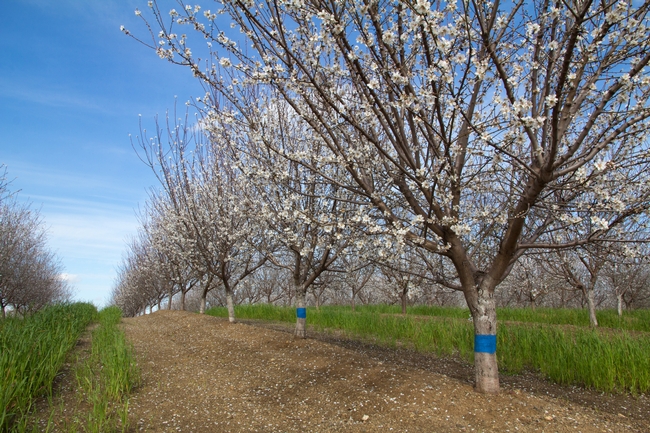 With advance notice from CalAgroClimate, farmers may be able to use heaters, wind machines, irrigation and other tactics to lessen some of the impacts of cold weather, such as damaging almond blooms. Photo by Will Suckow
With advance notice from CalAgroClimate, farmers may be able to use heaters, wind machines, irrigation and other tactics to lessen some of the impacts of cold weather, such as damaging almond blooms. Photo by Will Suckow

Free CalAgroClimate tool helps growers protect crops from frost and extreme heat
California farmers can see how climatic conditions that may affect agriculture are changing in their regions by using CalAgroClimate so they can make strategic changes. Nine new agriculturally important climate indicatorshave been added to the decision-support tool created by UC Cooperative Extension and U.S. Department of Agriculture scientists.
These new tools use a high-resolution climate dataset called PRISM to provide location-specific or county-aggregated long-term trends in agroclimatic indicators from 1980 to last year. These new agroclimate indicators include Frost Days, Last Spring Freeze, First Fall Freeze, Freeze-Free Season, Tropical Nights, Hot Days, Extreme Heat Days, Heatwaves and Diurnal Temperature Range (see definitions below). These indicators were derived from a study published in the journal Agronomy.
All of the new tools are free and available on CalAgroClimate for anyone to access.
“Frost-related tools such as Frost Days, Last Spring Freeze, First Fall Freeze, and Freeze-Free Season can help farmers and agricultural clientele make informed long-term choices,” said Tapan B. Pathak, UC Cooperative Extension specialist in climate adaptation in agriculture based at UC Merced, who is leading the CalAgroClimate project.
“For instance, if you are planning to invest in a frost sensitive crop in your region, these indicators can provide valuable information on whether frost risk has changed over time and whether it is less risky to make such an investment,” he said. “Wine grapes, for instance, are very sensitive to frost. Although not all frost events are damaging, understanding long-term trends in frost can help in making long-term strategic decisions such as whether to invest in frost protections.”
Another set of new agroclimatic indicators, on CalAgroClimate – Tropical Nights, Hot Days, Extreme Heat Days, Heatwaves and Diurnal Temperature Range – are based on higher maximum and minimum temperatures. Tropical Nights, for instance, calculates total number of nights when overnight temperatures exceed 68 F. More frequent tropical nights can increase crop respiration rates and can be detrimental for fruit quality and quantity, increase the risk of damage from pathogens, and potentially impact fruit set and yield.
Knowing how trends are evolving over time can assist growers in managing their crops to reduce risks. Similarly, growers can easily look at trends related to heat – hot days, extreme heat and heatwaves – on CalAgroClimate to assess their options on what they need to do to be adaptive. In the short term, growers may put up shade or for longer term, choose varieties that are more heat-tolerant.
“In recently published work, one of the farmers in the Central Valley told us, ‘When you really see so much difference in a short amount of time in your immediate area…we would have to look at that and say, well, we're going to have to adapt varieties because this is a 20- or 25-year planting and we're going to have to find crops or varieties that will adapt to that,'” Pathak said.
Another farmer told us, “Knowing what's going to happen or at least having a good idea, if you know something's going to be become or won't be viable, then obviously you're going to try to phase that out, and phase in something that's better suited.”
Pathak added, “The new agroclimatic indicators on CalAgroClimate provide a reality check on how conditions are changing in short and long-term, what it means for farmers and to assist them on deciding what they need to do to be adaptive. These tools will greatly benefit farmers and agricultural clientele in assessing risks and making informed decisions.”
Other collaborators include StevenOstoja and Lauren Parker of theUSDA California Climate Hub,PrakashKumarJha of UC Agriculture and Natural Resources and Robert Johnson and ShaneFeirer of UC Agriculture and Natural Resources' Informatics and Geographic Information Systems.
Definitions of AgroClimatic Indicators:
Frost Days are days in a year with minimum temperature below or equal to 32F.
Last Spring Freeze is the latest day in spring when minimum temperature is below or equal to 32F.
First Fall Freeze is the earliest day in fall when minimum temperature falls to 32F or below.
Freeze-Free Season is the time between the last spring and first fall freeze, represented by the number of consecutive days in a year without freezing temperatures.
Tropical Nights are number of nights when temperatures exceed 68F.
Hot Days are the days per year with maximum temperature exceeding 100 °F.
Extreme Heat Days are the number of days per year with maximum temperatures warmer than the 98th percentile of historical summer maximum temperature for the selected location.
Heatwaves are events that occur when extreme heat lasts for at least three consecutive days.
Diurnal Temperature Range is the difference between daily maximum and minimum temperatures.
Climate change may reduce frost damage to orchard crops
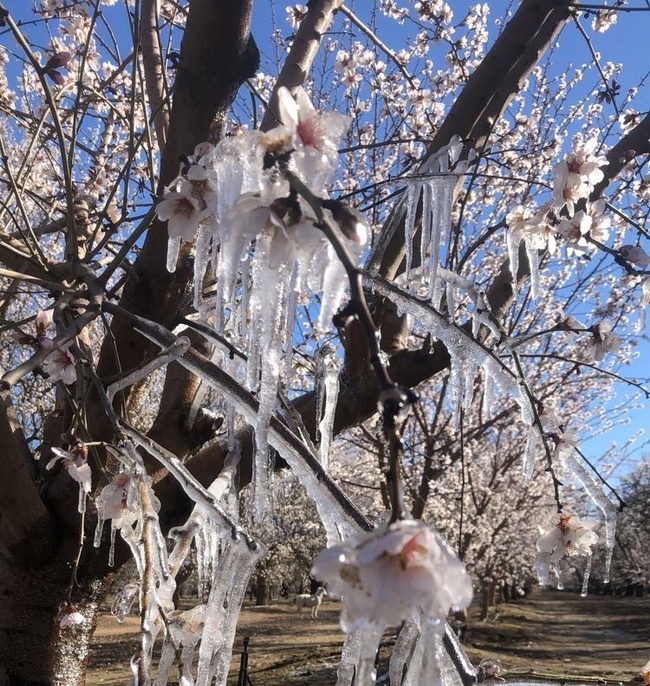
CalAgroClimate web tools help farmers prepare for frost events
A cold snap damaged almond blossoms across the Central Valley, resulting in more than $44 million in crop insurance claimsin late February 2018. A multi-day frost event wiped out roughly 75% of California's citrus crop and severely damaged avocados in January 2007. Frost can damage crops, impact growers' bottom lines and drive up food prices for consumers. With advance notice, farmers may be able to use heaters, wind machines, irrigation and other tactics to lessen some of the impacts of cold weather, such as damaging near-ripe citrus fruit or killing the bloom in almonds.
CalAgroClimate is a new farmer-focused website that can help growers anticipate weather-related risks and make plans for taking defensive action. Growers and crop consultants can use CalAgroClimate's crop and location-specific tools and resources to help prepare for upcoming frost events. The website's tools can also support on-farm decisions for managing heat, crop development and pests.
Future holds less frost
The risk of frost damage to crops and the need to prepare for that risk is top-of-mind for many farmers today, but will it always be so? To examine what climate change might mean for future frost risk, researchers at UC Davis, UC ANR and the USDA California Climate Hub conducted a study examining the incidence of temperatures below multiple “frost thresholds” during the months of critical development phases for three frost-sensitive California crops: almonds, avocados and navel oranges.
The researchers found that even during the coldest winters and springs, the incidence of frost exposure declined under projected mid-21st century climate conditions by more than 50% for almonds and oranges, and by more than 75% for avocados. While farmers in 2050 will not find frost risk to completely be a worry of climates past, they will not have to contend with the same frost concerns that farmers face today.
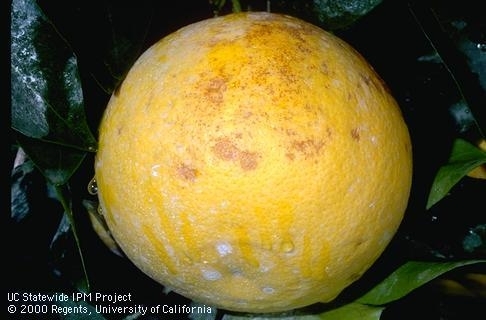
Few aspects of climate change are considered “positives,” and although the warming winters and springs that result in reduced frost temperatures could also come with increased pest pressure, reduced chill accumulation and other challenges, the reduction in frost exposure is a silver lining.
However, until this frost-free future arrives, growers still need to be prepared to protect their orchards from frost. To assess frost risk for the next seven days for your location, check out the new interactive Frost Advisory Tool at CalAgroClimate.org.
New interactive web tools help growers cope with climate change
UCCE, USDA California Climate Hub launch CalAgroClimate decision-support tool
Climate and weather variability pose increasing risks to farmers. As world leaders gather in Egypt at COP27 to address the climate crisis, University of California Cooperative Extension and the USDA California Climate Hub are launching new web-based tools to provide farmers with locally relevant and crop-specific information to make production decisions that reduce risk.
“Integrating historical weather data and forecast information with meaningful agricultural decision support information holds the potential to reduce a crop's vulnerability to such risks,” said Tapan Pathak, UC Cooperative Extension climate adaptation specialist at UC Merced.
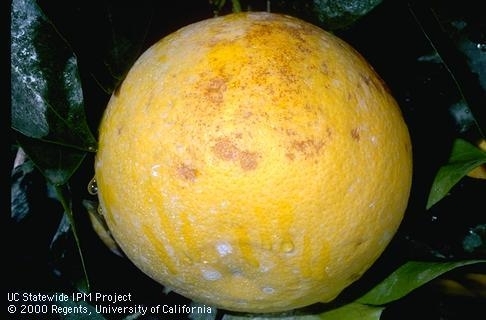
Pathak is collaborating on building the decision support tool with partners from the U.S. Department of Agriculture, California Climate Hub, UC Cooperative Extension and UC Agriculture and Natural Resources' Informatics and Geographic Information Systems or IGIS.
“CalAgroClimate has been designed to support climate-enabled decision making for those working in the California specialty crop industry,” said Steven Ostoja, Director USDA California Climate Hub. “The USDA California Climate Hub is a proud collaborator on this important initiative to ensure the state's agricultural industry can continue to thrive in a future of climate change.”
Shane Feirer and Robert Johnson of UC ANR IGIS designed the interactive tools on the website and Lauren Parker of the USDA California Climate Hub contributed to content organization.An advisory panel composed of colleagues from UCCE and the Natural Resources Conservation Service ensure CalAgroClimate tools are relevant to stakeholder needs.
“CalAgroClimate is an amazing new tool that puts comprehensive past and forecast weather data at any grower's disposal,” said Mark Battany, UC Cooperative Extension water management and biometeorology advisor for San Luis Obispo and Santa Barbara counties.
“California's high-value crops are subject to a myriad of weather-related risk factors; this tool will allow growers to better address both near-term and long-term risks, and in the end grow more profitably, said Battany, who is a member of the CalAgroClimate advisory panel.
Growers and crop consultants can use CalAgroClimate's crop and location-specific tools and resources to help make on-farm decisions, such as preparing for frost or untimely rain and taking advantage of expected favorable conditions.
CalAgroClimate currently includes heat advisory, frost advisory, crop phenology and pest advisory tools.
Heat advisory tool: Extreme heat poses a danger for people, animals and crops. With this tool, users can select location and temperature threshold (e.g. 90 F, 95 F 100 F) based on their crop-specific heat tolerance level and the tool will provide a customized map of heat risk for next seven days for that location, including the number of consecutive days with temperature above that threshold. Users can also assess overall heat risks across the state for a selected temperature threshold as well. Having an early warning about hot temperatures, growers can take steps to reduce risks associated with extreme heat such as providing shade, changing farm workers' schedules and applying additional irrigation.
Frost advisory tool: Frost risk is a very serious issue for many specialty crops across California. Similar to the heat advisory tool, this tool provides a customized map of frost advisory for next seven days for a user's location, and forecast of consecutive days with temperature falling below the selected temperature thresholds (e.g. 35 F, 32 F, 28 F). Similar to the heat advisory, early warning about cold temperatures can provide growers some time to protect their crops from frost damage.
Crop phenology tool: The scientists have developed a-crop specific and location-specific crop phenology tool to help users keep track of growing degree days accumulations and estimate critical growth stages. CalAgroClimate uses a high-resolution PRISM dataset to provide near real-time crop phenology information to users. This tool will inform growers about how their crop development compares to previous years, which can be helpful in planning activities specific to critical growth stages.
Pest advisory tool: Similar to crops, development of certain pests and diseases is controlled by temperature and heat unit accumulations. With the pest advisory tool, growers can keep track of estimated pest generations during the growing season to make pest management decisions.
“We are launching the website with this initial set of tools while working on adding more crop-specific information and several new tools in the near future, ” Pathak said. “We look forward to getting feedback from growers who use CalAgroClimate to make it even more useful.”

